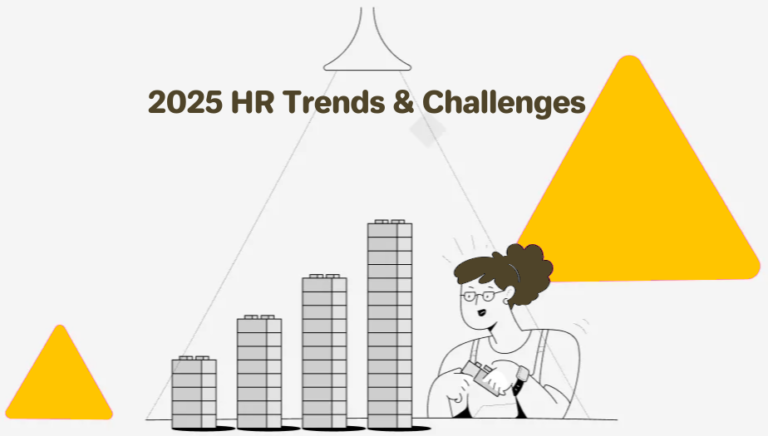7 HR Trends & Challenges in 2025

The workplace is evolving at an unprecedented pace, shaped by AI, automation, and shifting employee expectations. HR leaders must tackle key challenges, including overwhelmed managers, cultural misalignment, change fatigue, outdated HR technology, and the growing urgency of integrating AI into talent strategies. Here’s what’s shaping the future of HR in 2025:
Leadership & Manager Development
Leaders today are expected to take on more responsibilities than ever before, yet many feel unprepared. 75% of HR leaders believe managers are overwhelmed, and 70% say current leadership programs are not equipping them for the future (Gartner). Without strong leadership, organizations struggle with decision-making, employee engagement, and change management. HR teams must rethink how they develop leaders, moving beyond traditional training to real-world coaching, mentorship, and peer learning experiences.
Culture & Accountability
Company culture is often described as an organization’s greatest asset—but maintaining alignment between vision and execution is a persistent challenge. 57% of HR leaders say managers don’t enforce company culture, while 53% believe leaders do not hold themselves accountable for cultural values (Gartner). Without reinforcement from leadership, core values become empty statements. Organizations must embed culture into daily workflows through recognition programs, leadership modeling, and peer-driven accountability.
Change Management
Employees and leaders alike are struggling to keep up with rapid transformations, from evolving work models to new technologies. 73% of HR leaders report that employees are experiencing change fatigue, and 74% say managers are not equipped to lead change (Gartner). Without the right support, teams can feel disconnected and resistant to new initiatives. Organizations need structured change management strategies, clear communication, and peer-driven support systems to help employees adapt.
HR Tech & People Analytics
HR teams are under pressure to modernize processes and make data-driven decisions, yet many find their tools outdated. 55% of HR leaders say their current HR technology doesn’t meet evolving business needs, and 51% struggle to measure ROI (Gartner). People analytics can provide real-time insights into employee engagement, performance, and retention, helping HR teams make more informed decisions. AI-powered HR tools also streamline administrative tasks, allowing HR professionals to focus on strategic initiatives.
The Acceleration of Skills & Learning
New generations were born into technology, with endless access to self-learning resources through platforms like YouTube, Coursera, and AI-driven assistants. As AI and automation reshape industries, human skills must evolve faster than ever. 83% of HR leaders believe upskilling is essential for employees to stay competitive in an AI-driven job market (SHRM), yet only 29% of companies have proactively trained employees to work alongside AI.
For organizations, the challenge isn’t just offering training—it’s keeping learning continuous, accessible, and aligned with future needs. Companies that provide on-demand learning opportunities and peer-to-peer mentoring will not only attract top talent but also future-proof their workforce.
AI & Talent Strategy
AI adoption in HR is still in its early stages, but it’s rapidly transforming talent acquisition. Of the one in four companies using AI for HR tasks, nearly 2/3 only started in 2023 (SHRM). Organizations are leveraging AI for job descriptions, targeted job postings, resume screening, and automated candidate searches. AI is also helping companies enhance workforce planning by identifying skill gaps and predicting future talent needs. However, most businesses have yet to explore AI’s full potential in employee development, internal mobility, and performance management.
7. Leadership & Manager Development
New regulations are introduced every year, but the 2025 political landscape could bring significant changes for HR professionals. Policy shifts may introduce new compliance challenges or remove existing labor protections.
For example, changes in labor laws, workplace regulations, and immigration policies could impact how businesses hire and manage talent. A worker shortage may drive discussions on expanding worker visas, while shifts in overtime rules and independent contractor classifications could change how businesses structure employment. Additionally, states are increasingly implementing new laws on paid leave, AI governance, and workplace policies, requiring HR teams to stay ahead of compliance updates.
HR professionals must be proactive in monitoring regulatory changes and adapting policies accordingly. Businesses that integrate HR technology, legal expertise, and workforce planning will be better positioned to navigate uncertainty.
How Organizations Can Stay Ahead
To navigate these challenges, HR leaders must blend technology, learning, and culture into a cohesive strategy.
- Invest in leadership development – Peer mentoring, coaching, and real-world leadership experiences can help managers develop the skills they need to thrive.
- Reinforce company culture – Recognition platforms, leadership accountability, and peer-driven engagement help align values with daily behaviors.
- Support change with strong communication – Structured change management strategies, clear communication, and ongoing employee support ensure smoother transitions.
- Leverage HR tech and people analytics – AI-powered tools provide data-driven insights to enhance decision-making and improve workforce planning.
- Create a learning-first culture – Continuous upskilling and peer mentoring programs will keep employees competitive in an AI-driven world.
- Stay ahead of regulatory changes – HR teams must track new laws and policies, ensuring compliance through legal expertise, training, and adaptable workplace policies.
As 2025 approaches, HR’s role is more critical than ever. Organizations that embrace continuous learning, leverage technology, and build strong leadership pipelines will not only stay ahead of disruption but also create workplaces where employees can thrive.
